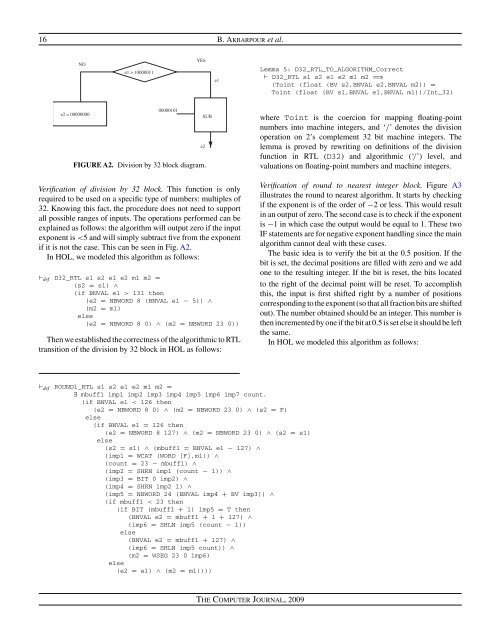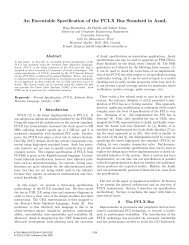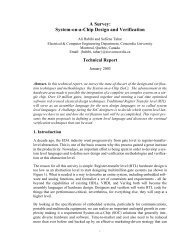Verifying a Synthesized Implementation of IEEE-754 Floating-Point ...
Verifying a Synthesized Implementation of IEEE-754 Floating-Point ...
Verifying a Synthesized Implementation of IEEE-754 Floating-Point ...
- No tags were found...
You also want an ePaper? Increase the reach of your titles
YUMPU automatically turns print PDFs into web optimized ePapers that Google loves.
16 B. Akbarpour et al.Lemma 5: D32_RTL_TO_ALGORITHM_Correct⊢ D32_RTL s1 s2 e1 e2 m1 m2 =⇒(Toint (float (BV s2,BNVAL e2,BNVAL m2)) =Toint (float (BV s1,BNVAL e1,BNVAL m1))/Int_32)FIGURE A2. Division by 32 block diagram.Verification <strong>of</strong> division by 32 block. This function is onlyrequired to be used on a specific type <strong>of</strong> numbers: multiples <strong>of</strong>32. Knowing this fact, the procedure does not need to supportall possible ranges <strong>of</strong> inputs. The operations performed can beexplained as follows: the algorithm will output zero if the inputexponent is 131 then(e2 = NBWORD 8 (BNVAL e1 − 5)) ∧(m2 = m1)else(e2 = NBWORD 8 0) ∧ (m2 = NBWORD 23 0))Then we established the correctness <strong>of</strong> the algorithmic to RTLtransition <strong>of</strong> the division by 32 block in HOL as follows:where Toint is the coercion for mapping floating-pointnumbers into machine integers, and ‘/’ denotes the divisionoperation on 2’s complement 32 bit machine integers. Thelemma is proved by rewriting on definitions <strong>of</strong> the divisionfunction in RTL (D32) and algorithmic (‘/’) level, andvaluations on floating-point numbers and machine integers.Verification <strong>of</strong> round to nearest integer block. Figure A3illustrates the round to nearest algorithm. It starts by checkingif the exponent is <strong>of</strong> the order <strong>of</strong> −2 or less. This would resultin an output <strong>of</strong> zero. The second case is to check if the exponentis −1 in which case the output would be equal to 1. These twoIF statements are for negative exponent handling since the mainalgorithm cannot deal with these cases.The basic idea is to verify the bit at the 0.5 position. If thebit is set, the decimal positions are filled with zero and we addone to the resulting integer. If the bit is reset, the bits locatedto the right <strong>of</strong> the decimal point will be reset. To accomplishthis, the input is first shifted right by a number <strong>of</strong> positionscorresponding to the exponent (so that all fraction bits are shiftedout). The number obtained should be an integer. This number isthen incremented by one if the bit at 0.5 is set else it should be leftthe same.In HOL we modeled this algorithm as follows:⊢ def ROUND1_RTL s1 s2 e1 e2 m1 m2 =∃ mbuff1 imp1 imp2 imp3 imp4 imp5 imp6 imp7 count.(if BNVAL e1 < 126 then(e2 = NBWORD 8 0) ∧ (m2 = NBWORD 23 0) ∧ (s2 = F)else(if BNVAL e1 = 126 then(e2 = NBWORD 8 127) ∧ (m2 = NBWORD 23 0) ∧ (s2 = s1)else(s2 = s1) ∧ (mbuff1 = BNVAL e1 − 127) ∧(imp1 = WCAT (WORD [F],m1)) ∧(count = 23 − mbuff1) ∧(imp2 = SHRN imp1 (count − 1)) ∧(imp3 = BIT 0 imp2) ∧(imp4 = SHRN imp2 1) ∧(imp5 = NBWORD 24 (BNVAL imp4 + BV imp3)) ∧(if mbuff1 < 23 then(if BIT (mbuff1 + 1) imp5 = T then(BNVAL e2 = mbuff1 + 1 + 127) ∧(imp6 = SHLN imp5 (count − 1))else(BNVAL e2 = mbuff1 + 127) ∧(imp6 = SHLN imp5 count)) ∧(m2 = WSEG 23 0 imp6)else(e2 = e1) ∧ (m2 = m1))))The Computer Journal, 2009





